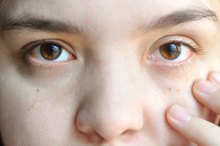What does fact checked mean?
At Healthfully, we strive to deliver objective content that is accurate and up-to-date. Our team periodically reviews articles in order to ensure content quality. The sources cited below consist of evidence from peer-reviewed journals, prominent medical organizations, academic associations, and government data.
The information contained on this site is for informational purposes only, and should not be used as a substitute for the advice of a professional health care provider. Please check with the appropriate physician regarding health questions and concerns. Although we strive to deliver accurate and up-to-date information, no guarantee to that effect is made.
Broken Blood Vessels and Eating Disorders
The appearance of broken blood vessels in the eyes is one of the visible symptoms of an eating disorder that includes frequent vomiting. Other physical signs include dry or blotchy skin, thinning or dry hair, and a swollen parotid gland, which is below the ear and behind the cheekbone on the neck. The broken blood vessels are due to straining during vomiting, but other signs might be related to malnutrition.
If you are experiencing serious medical symptoms, seek emergency treatment immediately.
Cause
If a person’s eating disorder involves frequent vomiting, blood vessels in they eye can swell and break due to the physical strain vomiting places on the body. When you throw up, your diaphragm and abdominal muscles contract to force your stomach contents up through your esophagus. Blood vessels in the eyes can swell and burst due to the strain, resulting in redness and blotchiness. Over-the-counter eye medications might help alleviate swollen or dilated eye blood vessels, but the healthiest strategy is to deal with the underlying cause.
- If a person’s eating disorder involves frequent vomiting, blood vessels in they eye can swell and break due to the physical strain vomiting places on the body.
- Blood vessels in the eyes can swell and burst due to the strain, resulting in redness and blotchiness.
Effect
Blood Shot Eyes When Working Out
Learn More
In extreme cases, subconjunctival hemorrhage can occur, which turns the white part of the eye red. This means a tiny blood vessel has burst just underneath the conjunctiva, or clear surface of the eye. The trapped blood can redden your entire eye, which is a scary sight, but it typically is harmless and fades away over the course of about two weeks, according to MayoClinic.com.
Bulimia
Bulimics often use binging and purging practices to control weight gain. During the binging period, they eat more food than is healthy. Immediately after eating, they force themselves to vomit to prevent the food from being digested. Vomiting regularly causes trauma to the body, including broken blood vessels in the eyes. Other visible signs of bulimia include face puffiness and teeth discoloration due to the continual presence of gastric juices in the mouth.
- Bulimics often use binging and purging practices to control weight gain.
- During the binging period, they eat more food than is healthy.
Considerations
Bloodshot Eyes in Children
Learn More
If you notice eye redness in someone you suspect has an eating disorder, contact a professional therapist, psychologist or counselor to help you identify the most effective way to help the person conquer the problem 2. Eye redness due to broken blood vessels should dissipate once the vomiting ceases, but the affected person should visit an eye doctor for a comprehensive examination to ensure there are no serious problems 2.
Related Articles
References
Writer Bio
Stan Mack is a business writer specializing in finance, business ethics and human resources. His work has appeared in the online editions of the "Houston Chronicle" and "USA Today," among other outlets. Mack studied philosophy and economics at the University of Memphis.









